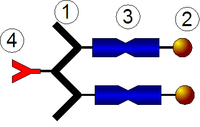
Photo from wikipedia
Serum albumin (SA) is the most abundant protein in plasma and represents the main carrier of endogenous and exogenous compounds. Several evidence supports the notion that SA binds single and… Click to show full abstract
Serum albumin (SA) is the most abundant protein in plasma and represents the main carrier of endogenous and exogenous compounds. Several evidence supports the notion that SA binds single and double‐stranded deoxynucleotides and ribonucleotides at two sites, with values of the dissociation equilibrium constant (i.e., Kd) ranging from micromolar to nanomolar values. This can be relevant from a physiological and pathological point of view, as in human plasma circulates cell‐free nucleic acids (cfNAs), released by different tissues via apoptosis, necrosis, and secretions, circulates as single and double‐stranded NAs. Albeit SA shows low hydrolytic reactivity toward DNA and RNA, the high plasma concentration of this protein and the occurrence of several SA receptors may be pivotal for sequestering and hydrolyzing cfNAs. Therefore, pathological conditions like cancer, characterized by altered levels of human SA or by altered SA post‐translational modifications, may influence cfNAs distribution and metabolism. Besides, the stability, solubility, biocompatibility, and low immunogenicity make SA a golden share for biotechnological applications related to the delivery of therapeutic NAs (TNAs). Indeed, pre‐clinical studies report the therapeutic potential of SA:TNAs complexes in precision cancer therapy. Here, the molecular and biotechnological implications of SA:NAs interaction are discussed, highlighting new perspectives on SA plasmatic functions.
Journal Title: IUBMB Life
Year Published: 2022
Link to full text (if available)
Share on Social Media: Sign Up to like & get
recommendations!